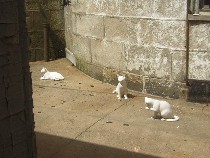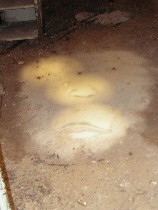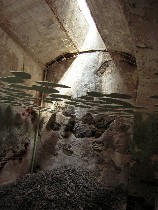
Eastern State Penitentiary is a monster of a place with damp, crumbling walls and depressing information about human folly and lives wasted. By time I finished looking at the six art installations there, I felt as uplifted as I felt depressed.
The art work is excellent and thoughtful; and the space is as tame as it has ever been, cleaner, less dangerous (the hardhats were eliminated a year ago), but still imposing, and still a monument to wrong-headedness.
The art work, on the other hand, needs to take a different tack, speak to the human condition. Most of the artists spoke to the edurance of the human spirit in the face of all odds.
Music for the souls
 Timothy Nohe‘s “142 Ways to Mark Time” was outstanding, a musical piece made up of recordings of rhythmic noises performed on parts of the prison–its rusting metal gates, wooden benches, fallen plaster, broken glass, locks. The recorded cadences are located in different cells, and each one is randomly timed in relationship to the other cadences.
Timothy Nohe‘s “142 Ways to Mark Time” was outstanding, a musical piece made up of recordings of rhythmic noises performed on parts of the prison–its rusting metal gates, wooden benches, fallen plaster, broken glass, locks. The recorded cadences are located in different cells, and each one is randomly timed in relationship to the other cadences.
The randomness has the influence of John Cage, but the music was accessible, moody and evocative as its taps and scrapes and scratchings echoed through Cellblock 10 and its cathedral-like spaces.
Nohe, a professor of visual arts at the University of Maryland Baltimore County, imagined the experiences of the earliest prisoners at Eastern State, who were hooded when they were moved out of their cells. He said he imagined them counting on the regularity of sounds around them to make sense of what was going on and to keep a grip on time.
 Nohe’s piece also had a visual component, a kind of documentation via photographs of the performances and “each sonic environment.” The photos were printed on orchestral score paper and bound in folios resting on old-fashioned wooden music stands positioned at each end of the cellblock.
Nohe’s piece also had a visual component, a kind of documentation via photographs of the performances and “each sonic environment.” The photos were printed on orchestral score paper and bound in folios resting on old-fashioned wooden music stands positioned at each end of the cellblock.
The visuals seemed overwhelmed by the brute space, but I loved the idea of a music folio, translating the sound sources and into another dimension. But it was the soundthat held the cathedral-like space.
Of cats and men
 Linda Brenner‘s “The Ghost Cats”–there are 39 of them dispersed through the prison–walk, sun and groom among the ruins. The graceful white statues commemorate the cat colony that inhabited the prison for 28 years and the man who cared for them. Dan McCloud came to the prison three times a week to feed them.
Linda Brenner‘s “The Ghost Cats”–there are 39 of them dispersed through the prison–walk, sun and groom among the ruins. The graceful white statues commemorate the cat colony that inhabited the prison for 28 years and the man who cared for them. Dan McCloud came to the prison three times a week to feed them.
The cats were no so different from the imprisoned humans, who depended on their guards to keep them alive. The creatures made a cat life for themselves within the prison walls, becoming an extended cat family, just as the prisoners found ways to connect with one another and create some sort of way to endure.
 As for McCloud, he’s on the audiotour in an old interview, talking about his own need to endure and the role of the cats in keeping him alive: “I’m afraid to stop now [feeding the cats] because I figure the Guy Upstairs might not need me no more.”
As for McCloud, he’s on the audiotour in an old interview, talking about his own need to endure and the role of the cats in keeping him alive: “I’m afraid to stop now [feeding the cats] because I figure the Guy Upstairs might not need me no more.”
The cats, cast in hydrocal, were designed to last as long as the show show needs them, through November. The real cats are long gone, having died out eventually, not from lack of food but because of neutering and speying.
The kitties, whose thickish legs remind me of Bast, the Egyptian cat god, are nice surprises, popping up in unexpected places.
View from the bottom of the bowl
 A poetic inverted sundial, “midway of another day,” came from Michael Grothusen, who created a bowl that holds the shadow of its own rim as the sun moves across the sky, slowly, each day. Grothusen will mark the arcs cast at various times and dates throughout the summer. Some are already marked.
A poetic inverted sundial, “midway of another day,” came from Michael Grothusen, who created a bowl that holds the shadow of its own rim as the sun moves across the sky, slowly, each day. Grothusen will mark the arcs cast at various times and dates throughout the summer. Some are already marked.
 Grothusen’s bowl didn’t look like it was part of the detritus of the prison–it was too perfect and shiny and silvery. It reminded me of a park decoration, a fountain of some kind. But the interior focus and suggestion of a perimeter too high to look beyond seemed like the interior focus of the cells themselves.
Grothusen’s bowl didn’t look like it was part of the detritus of the prison–it was too perfect and shiny and silvery. It reminded me of a park decoration, a fountain of some kind. But the interior focus and suggestion of a perimeter too high to look beyond seemed like the interior focus of the cells themselves.
And the shadow marking time was a reminder of the small glimpse of the sky in each cell, and how that might have kept the prisoners connected to time, weather, the universe.
Prison of the young mind
 Nick Cassway (see my post on his piece at Nexus) made his own death row, a kind of shooting gallery of portraits of approximately half those on death row today who were sentenced as juveniles. The portraits were created by rustproofing some areas on 24″ x 36″ steel plates. Time and the weather did the rest.
Nick Cassway (see my post on his piece at Nexus) made his own death row, a kind of shooting gallery of portraits of approximately half those on death row today who were sentenced as juveniles. The portraits were created by rustproofing some areas on 24″ x 36″ steel plates. Time and the weather did the rest.
 Cassway is a painter of souls, and this piece is no exception, the young faces surviving for now, yet taking a beating, in their decaying surroundings. The long time prognosis for the prisoners is even worse than for the rusting metal. This piece was more didactic and less complex than some of Cassway’s meditations on materiality and lack thereof.
Cassway is a painter of souls, and this piece is no exception, the young faces surviving for now, yet taking a beating, in their decaying surroundings. The long time prognosis for the prisoners is even worse than for the rusting metal. This piece was more didactic and less complex than some of Cassway’s meditations on materiality and lack thereof.
The face behind the number
 “Cellblock Nine,” by Ianthe Jackson, was inspired by the ex-cons she taught. She showed nine ghostly, animated portraits of different psychological states projected onto the floor. Her goal, she said was to recognize the complexity of them as individuals. The prisoner portraits seem to disappear into the floor on which they are projected. The jerky animation seemed inconsistent with the drawing and undercut the serious point being made.
“Cellblock Nine,” by Ianthe Jackson, was inspired by the ex-cons she taught. She showed nine ghostly, animated portraits of different psychological states projected onto the floor. Her goal, she said was to recognize the complexity of them as individuals. The prisoner portraits seem to disappear into the floor on which they are projected. The jerky animation seemed inconsistent with the drawing and undercut the serious point being made.
Prison chapel
 The only piece that seemed less about the people imprisoned and more about decay of the once mighty fortress-like space was offered by brothers Matthew & Jonathan Stemler. “Juxtaposition” creates a sort of cloud layer suspended like a dropped ceiling in one of the cells. The low layer, which spoke of prison life’s limits and blocked views, was created from lily-pad shaped pieces of suspended fallen plaster. The observation seat gave a nice escape from the dropped ceiling, and added to the sense of a small chapel created by the light streaming in.
The only piece that seemed less about the people imprisoned and more about decay of the once mighty fortress-like space was offered by brothers Matthew & Jonathan Stemler. “Juxtaposition” creates a sort of cloud layer suspended like a dropped ceiling in one of the cells. The low layer, which spoke of prison life’s limits and blocked views, was created from lily-pad shaped pieces of suspended fallen plaster. The observation seat gave a nice escape from the dropped ceiling, and added to the sense of a small chapel created by the light streaming in.
I also loved the two hills of detritus on the floor, although I was puzzled by seeing the plywood undersupport, which offered too sharp an angle for the rocks to rest without slipping. On the other hand, I thought, well, they look like coffins under the rocks. How appropriate.
I want to add that the audiotour, with the artists speaking about their own pieces, gave you control over where you wandered in which order and what you listened to. It was a plus.









